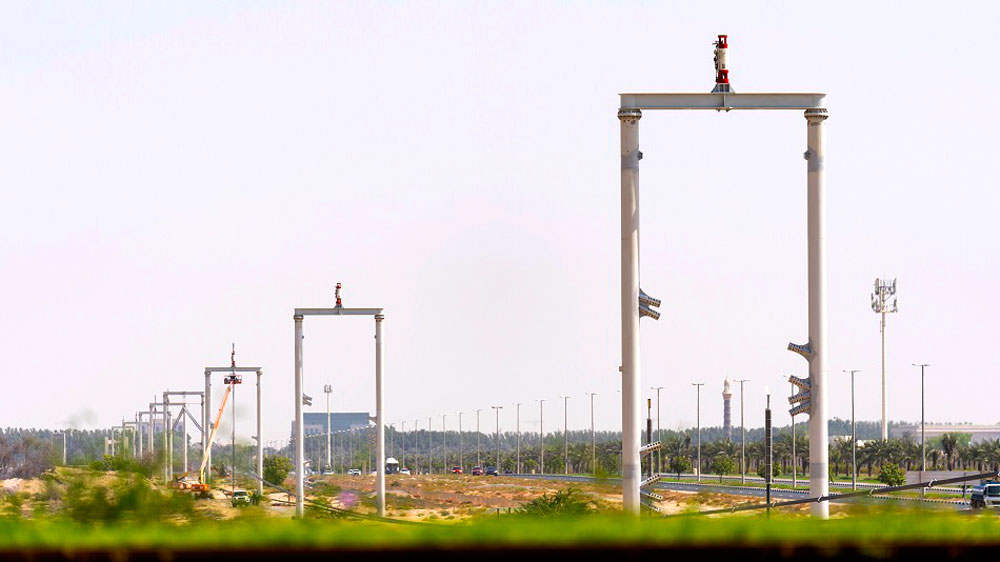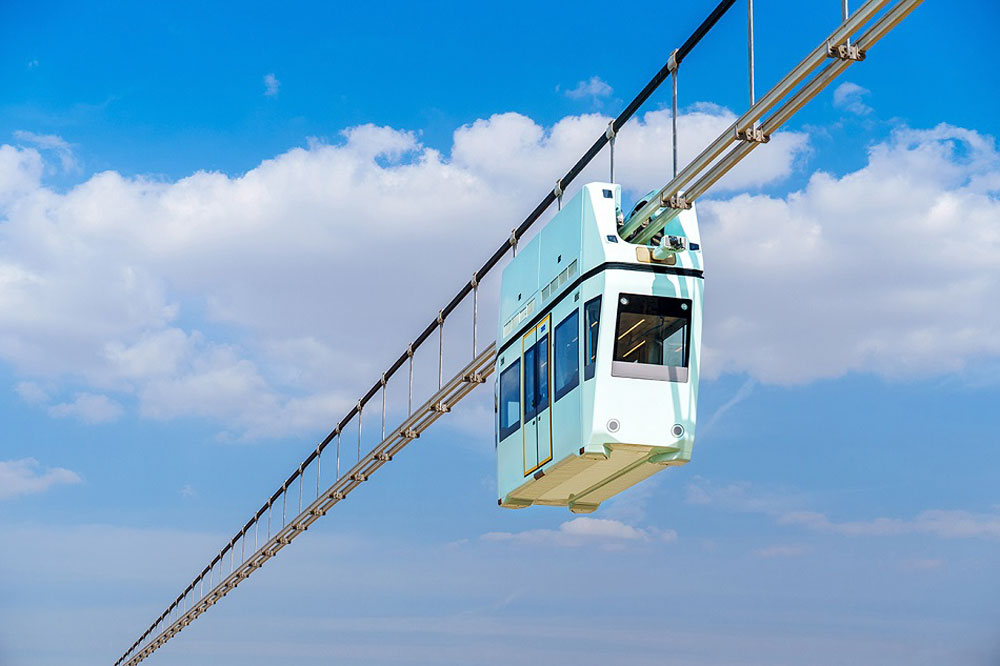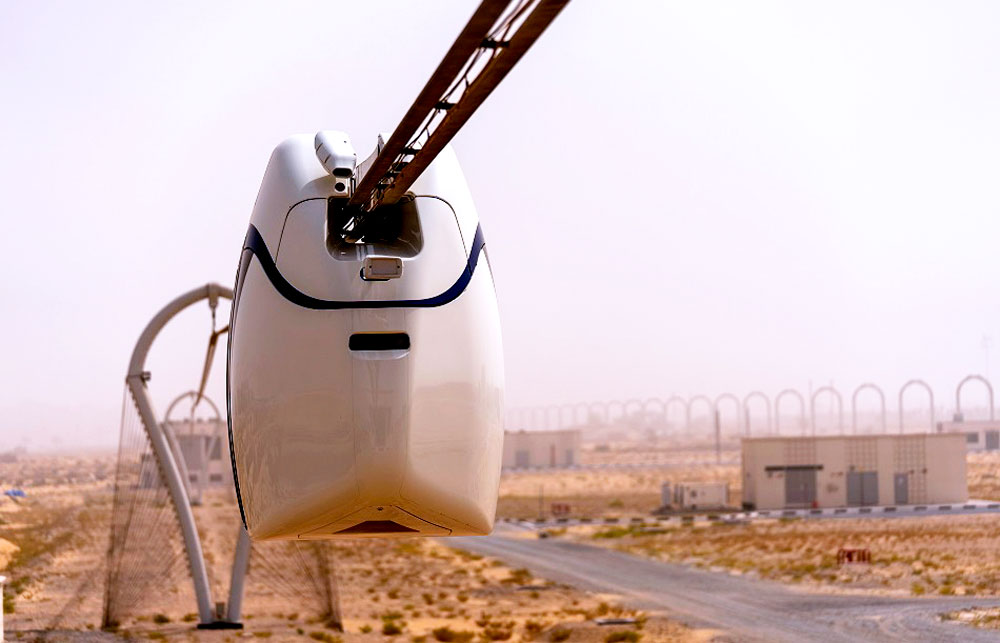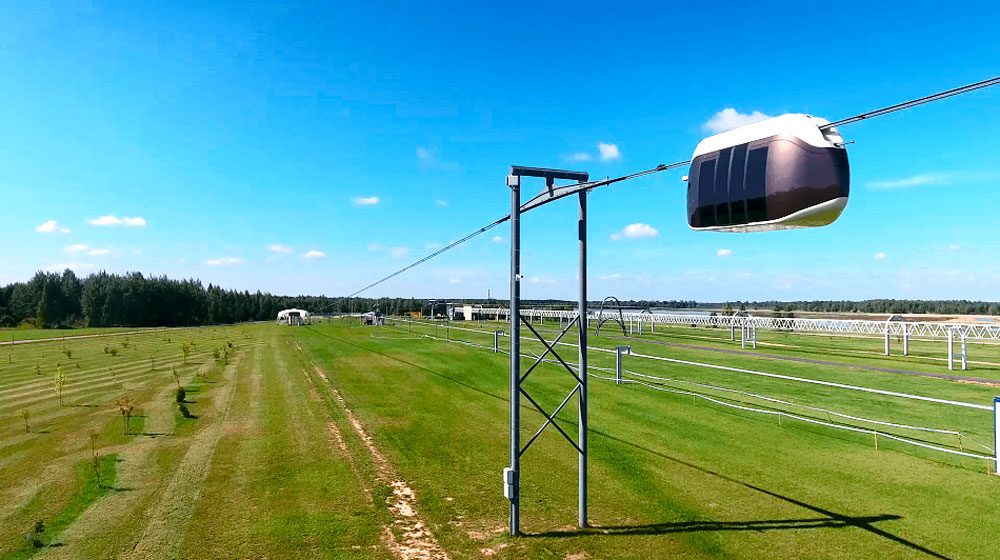


The development of string rail transport, proposed by Unitsky String Technologies Inc., is accompanied by the implementation of unique engineering solutions. One of the key elements of the track structure is the swivel support. These components provide route flexibility, allowing paths to be laid across complex terrain and adapted to urban landscapes. Let’s explore the operating principles of swivel supports, their structural features, and technical limitations.
Unlike traditional railways or highways, string rail routes are designed to follow the straightest possible trajectory. This approach helps save materials, reduce track length, and increase transport speed. However, it’s impossible to eliminate curvature entirely—routes must bypass buildings, water bodies, utility infrastructure, or terrain features. Swivel supports are used to solve this challenge by defining the angle of curvature for the string rail.
A swivel support is a massive structure capable of withstanding horizontal loads that arise when the route changes direction. It differs from supporting towers by having a reinforced design, a larger base, and a specialized mounting system for the string rail track.

Key components of a swivel support include:
When designing the entire route, it’s taken into account that the load from the turn is absorbed by several components: the bundle of rods inside the beam, the supporting saddle, and the foundation. This integrated approach ensures high rigidity and long-term durability of the structure.
At the core of the swivel support’s function lies the ability of the string rail beam to bend within the horizontal plane. Inside the beam is a bundle of pre-stressed rods that absorb the primary force. When the route trajectory changes, the string rail is fixed in the required position, and the bending moment is redistributed between anchoring structures and supporting towers.

uPods (the rolling stock of the uST complex) use a system of steerable wheelsets when navigating turns, which ensures rail adhesion and stable movement. Additional safety elements prevent derailment even under lateral overloads. Thus, the swivel support performs two key functions:
The maximum turning angle depends on the type of route, travel speed, and the purpose of the complex.

This means the route can be designed with any necessary bends (both vertical and horizontal), but their radius and frequency will depend on the calculated speed and throughput of the complex.

The minimum curve radius is 10 meters—typically found near stations, terminals, or garages combined with maintenance facilities, where the speed of rail-based electric vehicles is close to zero. On curved sections with a radius under 100 meters, the rail is constructed without strings (similar to conventional railway rails) and supported by beam or truss span structures of either standard or string type. Anchoring structures may be combined with swivel supports at stations or shared between two track structures at a turn.
The use of swivel supports in uST transport infrastructure complexes offers a range of engineering benefits. For example, route flexibility allows for bypassing buildings, natural obstacles, and utility structures, eliminating the need for tunnel excavation and large-scale earthworks. String rail tracks can also be laid in densely built environments while preserving the architectural character of existing infrastructure. Moreover, the smooth trajectories of string rail track structures ensure stable movement of uPods, creating safe and comfortable conditions for passengers.
Today, specialists at UST Inc. are actively refining swivel support technology. Durable composite materials, new methods for tensioning and securing string rails, and intelligent monitoring systems that track loads and predict wear are being implemented. All of this enhances the longevity of the track and improves its adaptability to urban environments.
In the future, swivel supports will become one of the key components of smart cities and innovative transportation systems, where routes are designed based on dynamic passenger flow models and seamlessly integrated into complex infrastructure.
Swivel supports in uST string rail complexes are a vital structural element that provides the necessary flexibility and functionality for the track. Thanks to these supports, string transport can be smoothly embedded into urban landscapes, navigate challenging terrain, and remain safe, fast, and economically efficient. The maximum turning angle depends on the line class and travel speed: from 10–15° on urban routes to minimal angles in high-speed projects.

Thus, the swivel support transforms the linear concept of the string rail into a versatile solution for modern above-ground transport, unlocking new possibilities for its use in megacities and interregional projects.
This form asks for your consent to allow us to use your personal data for the reasons stated below. You should only sign it if you want to give us your consent.
Who are we?
The name of the organisation asking you for consent to use your information is:
Global Transport Investments
Trident Chambers, P.O. Box 146, Road Town
Tortola
British Virgin Islands
We would like to use the following information about you:
Why would we like to use your information?
Global Transport Investments would like to send this information to company registry, inform you about its news, for refund purposes.
What will we do with your information?
We store your name, address, ID Data, date of birth into company registry. We will share your e-mail & phone number with IT Service (https://digitalcontact.com/), SMS Center (http://smsc.ru). They will add your details to their mailing list and, when it is news update, they will send you an email or sms with details. We store your credit card number for possible refunds.
How to withdraw your consent
You can withdraw the consent you are giving on this form at any time. You can do this by writing to us at the above address, emailing us at the address: [email protected] or by clicking on the unsubscribe link at the bottom of emails you receive.
This privacy notice tells you about the information we collect from you when you sign up to receive our regular newsletter via our website. In collecting this information, we are acting as a data controller and, by law, we are required to provide you with information about us, about why and how we use your data, and about the rights you have over your data.
Who are we?
We are Global Transport Investments. Our address is Trident Chambers, P.O. Box 146, Road Town, Tortola, British Virgin Islands. You can contact us by post at the above address, by email at [email protected].
We are not required to have a data protection officer, so any enquiries about our use of your personal data should be addressed to the contact details above.
What personal data do we collect?
When you subscribe to our newsletter, we ask you for your name and your email address.
Why do we collect this information?
We will use your information to send you our newsletter, which contains information about our products.
We ask for your consent to do this, and we will only send you our newsletter for as long as you continue to consent.
What will we do with your information?
Your information is stored in our database and is shared with with IT Service (https://digitalcontact.com/), SMS Center (http://smsc.ru). It is not sent outside of the Euro. We will not use the information to make any automated decisions that might affect you.
How long do we keep your information for?
Your information is kept for as long as you continue to consent to receive our newsletter.
Your rights over your information
By law, you can ask us what information we hold about you, and you can ask us to correct it if it is inaccurate.
You can also ask for it to be erased and you can ask for us to give you a copy of the information.
You can also ask us to stop using your information – the simplest way to do this is to withdraw your consent, which you can do at any time, either by clicking the unsubscribe link at the end of any newsletter, or by emailing, writing us using the contact details above.
Your right to complain
If you have a complaint about our use of your information, you can contact the Information Commissioner’s Office.
Rate and Comment
You can assess the importance of a particular publication and the level of its preparation. Share your opinion in the comments!